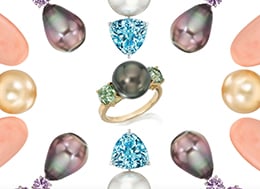Know Your Pearl Types—A Quick Review for Retailers and Designers
June 22, 2022

"This much is clear: pearls are on fire in the jewelry market. Having wholly shed their matronly reputation (born of pearl-clad 1950s housewives) to become a firm favorite with Millennial and Gen-Z celebs—Harry Styles, Justin Beiber, Billie Eilish and Rihanna are regular pearl-wearers—they’re now surefire sellers in jewelry stores spanning the globe.
But along the way, the labeling of pearl types has gotten a little…fast and loose. As a true pearl neophyte, I was eager to learn the legit names and origins of the dozens of pearl variations on the market at this year’s Las Vegas Jewelry Week. What I learned was that while some dealers are diligent about labeling their goods correctly, others are, well, casual with their pearl terms. Seeking some clarity, I headed to GIA’s website, and a handful of other smart sources.
There are two types of pearls
To begin with, there are two types of pearls: natural (“formed in the bodies, or mantle tissue, of certain mollusks, usually around a microscopic irritant, and always without human help of any kind,” according to GIA); and cultured pearls, which are the result of the deliberate insertion of a bead or piece of tissue into a mollusk that then coats it with nacre, the stuff of pearl. The vast number of pearls on the market today are cultured pearls.
There are four major types of cultured whole pearls—they are:

Gray freshwater cultured pearls from Rio Grande
Freshwater Cultured Pearls
These are the most common pearls on the market, “due to their remarkable range of sizes, shapes and colors, plus their commercial availability at lower price points,” writes GIA. They’re usually cultured in freshwater lakes and ponds, and often many pearls form in one oyster. China is the leading grower of freshwater cultured pearls.

Tiffany & Co. Akoya pearl earring
Akoya Cultured Pearls
Always saltwater, usually white or cream—both China and Japan produce akoya cultured pearls. These guys are perfectly round and considered the top-shelf offering in pearls.

American Pearl 14k gold ring with two deep golden South Sea pearls
South Sea Cultured Pearls
When you see huge pearls, they are usually South Sea cultured pearls, which “can be white to silver or golden, depending on the type of oyster,” according to the GIA. “Australia, Indonesia, and the Philippines are leading sources of these saltwater cultured pearls. Their large size and thick nacre, due to a long growth period, plus their limited critical growing conditions are all factors contributing to their value.” (Note: there’s a lot to know about South Sea pearls—if you’re curious, here’s a good place to start)

Tahitian South Sea pearls from the Pearl Source
Tahitian Cultured Pearls
A.k.a. black pearls! These pearls are cultivated around the islands of French Polynesia. And they actually boast a wide color range, from gray, black, and brown to blue, green, purple, and pink.
Knowing all this, I wondered about the origins of the pearl type du jour at this year’s Las Vegas Jewelry Week, and at the AGTA GemFair in particular—baroque pearls.
These freeform-shaped pearls, which can grow as big as giant’s thumb, are having a major moment right now, with hip young jewelry brands and established ateliers (see Chan Luu and WWAKE) playing with drilled and un-drilled baroque pearls in their current collections.
Check out these baroque pearl earrings from indie designer Sofia Zakia:

And these pieces from emerging jewelry brand Adore Adorn (we spotted them at JCK Las Vegas):

Baroque pearls are usually cultured in freshwater, though they can be cultured in salt water. And all natural pearls are technically baroque, since perfectly spherical pearls require human intervention (see the history of cultured pearls here). The most valuable baroque pearls are the South Sea and the Tahitian pearls, which are produced by Pinctada margaritifera (black-lipped oysters) and Pinctada maxima (gold-lipped and white-lipped oysters).
So, what about natural pearls? Do they exist in the market? ... "
https://thezingreport.com/2022/06/know- ... e=hs_email